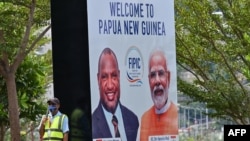Indian Prime Minister Narendra Modi heads to Papua New Guinea later this week for a visit aimed at shoring up India’s outreach to Pacific Island countries, with an eye on countering China’s growing footprint in the Pacific.
The first visit by an Indian prime minister to the largest of the Pacific Island nations comes as New Delhi’s hostilities with Beijing have prompted it to work more closely with countries such as the United States, Japan and Australia in the Indo-Pacific region.
Modi will stop in Papua New Guinea capital Port Moresby on the second leg of a three-nation tour during which he will first attend the Group of Seven summit in Japan and then go on to Australia.
On May 22, Modi and Papua New Guinean Prime Minister James Marape will host the third summit of the Forum for India-Pacific Islands Cooperation, a grouping of India and 14 Pacific Island countries.
The summit, which is being held eight years after India hosted the last one in 2015, could give fresh momentum to New Delhi’s bid to establish a presence in the Pacific Island countries. India began its outreach in 2014, but it has been slow to get off the ground.
“Those places are very strategic if you want to make a naval base or a friendly port or friendly airstrip and they also have vast ocean resources,” retired navy chief Arun Prakash told VOA Tuesday.
“The main worry for Western countries and India is that several of these countries are a void and China tends to walk into voids and fill them up.”
The 14 countries set to participate in the Port Moresby summit range from such large islands as Fiji, Papua New Guinea and the Solomon Islands to smaller ones such as Tonga and Tuvalu. The other countries will be Kiribati, Samoa, Vanuatu, Niue, Micronesia, Marshall Islands, Cook Islands, Palau and Nauru.
Papua New Guinea is especially significant. The island of 9.5 million is the largest of the Pacific Island countries and one of the few with which India has longstanding ties and a trade relationship. It is also home to a small Indian population of about 3,000.
Modi and Marape will meet Monday and the two sides are expected to sign pacts that include cooperation in micro- and small to medium enterprises to agreements between their state broadcasters and reciprocal arrangements for issuing visas on arrival.
“One of the important challenges that Papua New Guinea faces is climate change and adaptation. These are areas where India can play an important role by offering affordable partnerships in areas like solar energy,” Swati Prabhu, an associate fellow at the Center for New Economic Diplomacy in New Delhi told VOA.
Papua New Guinea also wants to shift its economy from export of primary materials such as natural gas and minerals to finished products.
The country is being courted by the U.S. and its allies amid concerns about China’s growing military and economic influence in the region. Chinese President Xi Jinping visited in 2018.
U.S. President Joe Biden was to visit Papua New Guinea on May 22 but has canceled the visit to focus on debt limit talks in Washington.
China has begun making inroads in the Pacific Island countries with its Belt and Road initiative – last year Beijing signed a security deal with the Solomon Islands and in March it won a contract to redevelop the port in its capital city, Honiara.
Analysts say India hopes to partner with the Pacific Island countries with development initiatives in areas such as clean energy, technology and community development projects such as solar electrification and supply of agricultural equipment.
Affordable clean energy initiatives are especially important in a region whose leaders say climate change is their greatest security threat amid worsening cyclones and rising sea levels.
Some see India’s outreach to the Pacific Island countries as part of its ambitions to be viewed as an emerging global power.
Analysts however say that while India’s bid to build influence in the Pacific Island countries marks an ambitious beginning, it has its limitations as it cannot match China’s resources and New Delhi’s primary focus will have to remain on its immediate neighborhood in South Asia and the Indian Ocean.
“If you call yourself an Indo-Pacific power and are part of the Quad grouping, you must make some outreach to the Pacific also. But whether it is within our capabilities to sustain ourselves that far out in the Pacific is a question mark. We don’t have such deep pockets and our navy is also relatively small,” Prakash said. “But perhaps in coordination with Japan, Australia and United States, we can render assistance there,” he said.






